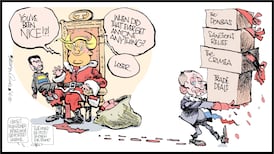She is identified as “M” in the Supreme Court judgment of February 26th this year. The sketch it paints of her life could hang in a hall of horrors.
In her 17-year existence, she has been physically, emotionally and sexually abused. She has suffered neglect. Her mother is in jail. She has witnessed “horrific” domestic violence committed against her sister by a partner. Some of her siblings have died.
She was living with her father when she was found in the house of a known sex offender and was taken into State care. She has turned to alcohol and drugs, thieving and an attempted arson. One time, she was admitted to intensive care after swallowing heroin cut with fentanyl and benzodiazepines. Another time, an ex-boyfriend posted intimate pictures of her online, taken after she had consumed cocaine. The court was told there was “a significant worry around whether she can actually stay alive in the short to medium term”.
Undoubtedly, “M” meets the criteria for the high-support residential care necessary for young people at severe risk. So why was her case brought before the Supreme Court? Because Tusla, the Child and Family Agency, had refused to apply for a court order to detain her in a special care unit on the grounds that it had no place available. The same rationale applied to “B”, a vulnerable teenage boy diagnosed with oppositional defiant disorder, among other conditions. He has been in 15 different placements, including hotels and “social admissions” to hospital, and has often gone missing while in State care. The court heard he was frequently intoxicated, violent and dealing drugs. His jaw was broken in one altercation. Tusla’s social work department feared his behaviour was putting his life “at immediate risk” and recommended, in vain, that a judicial special care order be obtained. When judges compelled Tusla to make the applications for “M” and “B” and then issued them, Tusla appealed to the Supreme Court.
READ MORE
Writing the unanimous decision of a five-judge court to uphold the orders, Mr Justice Gerard Hogan observed: “A statutory agency such as the CFA [Child and Family Agency] is bound to uphold the Constitution and the law. It is not entitled to take it upon itself – even for the best of motives – to disregard that which the Oireachtas has prescribed as mandatory.” Since 2018, the High Court has had the statutory power to order the detention of children aged 11 to 18 with damaging behavioural problems in special units with therapeutic and on-site educational provision and higher staff levels.
Last Sunday, Simon Harris said in a Newstalk radio interview that his single biggest ambition as Taoiseach was to make Ireland a great country for children. Any listener who has worked with the least fortunate children in the land and watched their circumstances deteriorate will have groaned with deja vu. Among them might have been the former High Court president, Judge Peter Kelly, who had to threaten to hold three cabinet ministers in contempt a quarter of a century ago before a suitable care place was found for a troubled girl.
The State has again been failing children in its care for at least the past decade. In 2013 the Children’s Ombudsman recommended that a strategic development plan for all children in residential care be urgently devised. It came in January 2022, targeting the creation of 104 extra beds, 41 of them to be provided by voluntary services. Those beds have yet to materialise, primarily because staff cannot be found for what is very challenging, low-paid work.
In May last year, former District Court judge Dermot Simms of the Dublin Metropolitan child care courts told the government in a letter that up to 130 highly vulnerable children were in unsuitable or unapproved and unregulated placements, such as hotels and B&Bs, because there was nowhere else for them to go. This week, the Supreme Court agreed to hear an “urgent” appeal by Tusla after the High Court found it in contempt for failing to detain a 14-year-old boy in a special care unit. There have been warnings that future compensation cases loom when some of these children become adults and seek redress for how the State has failed them.
The Supreme Court’s judgment in the cases of “M” and “B” came the week before the roundly-rejected family and care referendums on March 8th but, despite its shocking details, it had no impact on the debate. A month later, the High Court heard that another girl had been sent to a residential unit in Britain by private jet and that the cost of her placement would be in the “tens and tens of thousands of euro each month”. Tusla’s barrister said her client had no discretion to attract staff by offering higher salaries because of public pay agreements. Judge John Jordan described the girl’s situation as “something of an Irish solution to an Irish problem”.
The Child Law Project regularly reports on disturbing cases that come before the courts, such as a special care order for an 11-year-old boy whose propensity for violence was “extraordinary”, including arson, substance abuse and “a litany of Pulse entries” in Garda crime logs. We hear these stories. We gasp. And then we go on as before. Why even have a Children’s Ombudsman or a Special Rapporteur on Child Protection or Hiqa reports if their warnings are ignored? If that is how those agencies are to be treated, the money they cost would be better spent by giving it to voluntary agencies caring for children at risk. If Tusla is finding it hard to recruit staff because of low pay rates, the non-profit sector is even more hampered because it is excluded from the State’s agreed salary increases and pensions.
Money can ameliorate the children’s care crisis. Wednesday’s report of yet another tax bonanza for the State’s coffers has fuelled speculation about a pre-election “giveaway budget”. There are, of course, no votes to be got from investing in the country’s most troubled children. For the majority of citizens, it is an invisible crisis and its resolution would be just as invisible, unlike tax cuts. But, if the Taoiseach is sincere about his ambition for Ireland, he will ensure sufficient money is allocated to provide proper care for the country’s youngest and most vulnerable people. Because a country that is great for only some of its children is not a great country at all.













